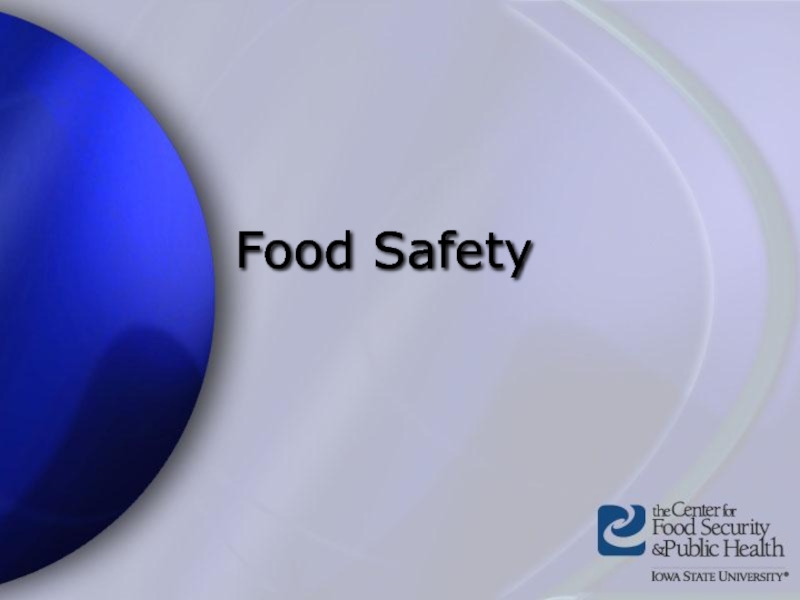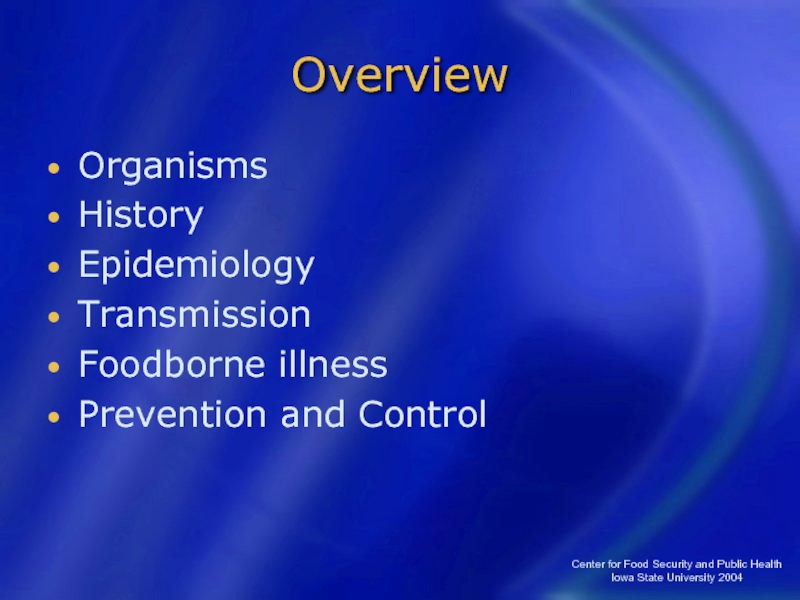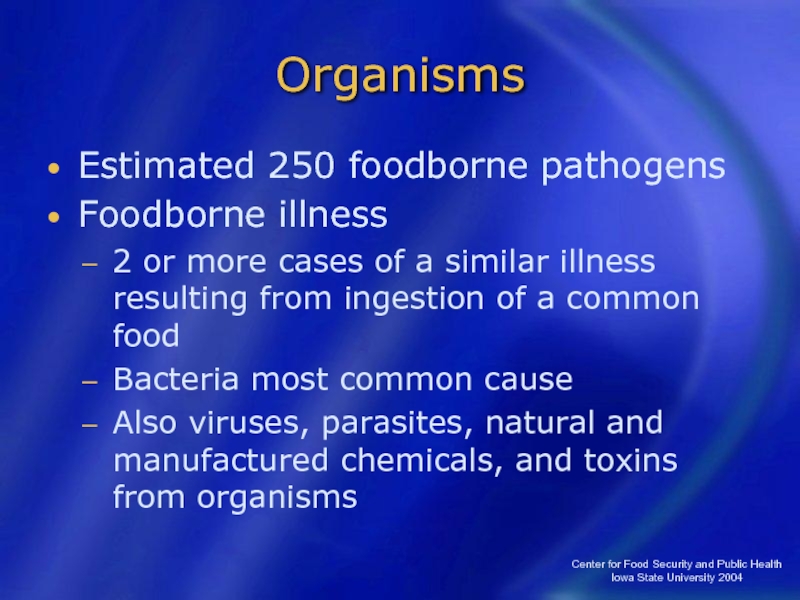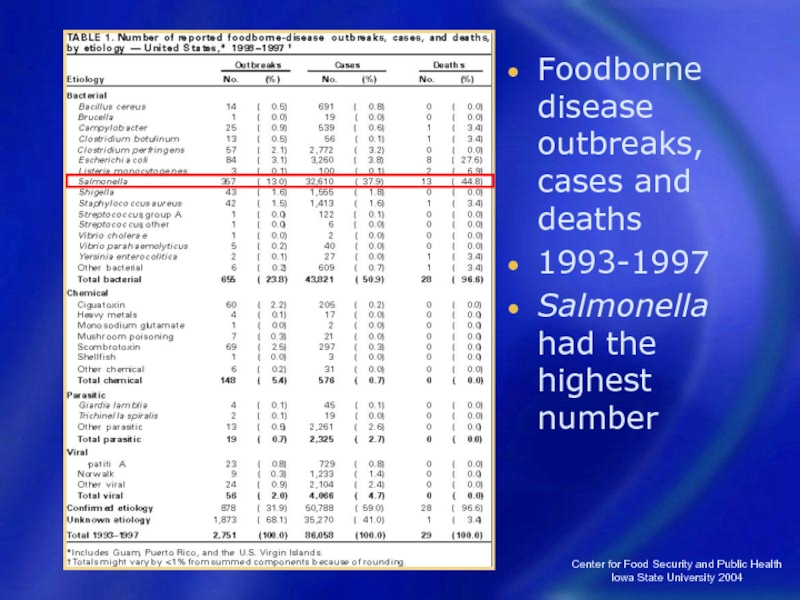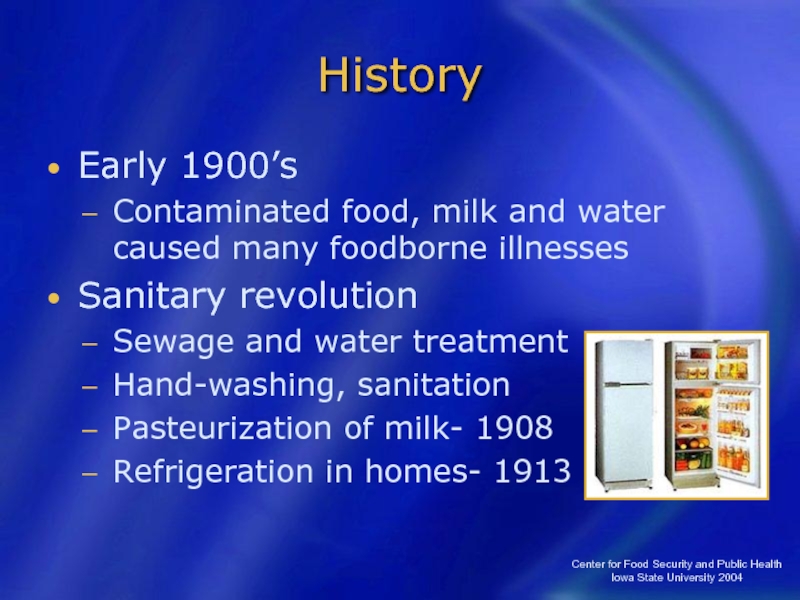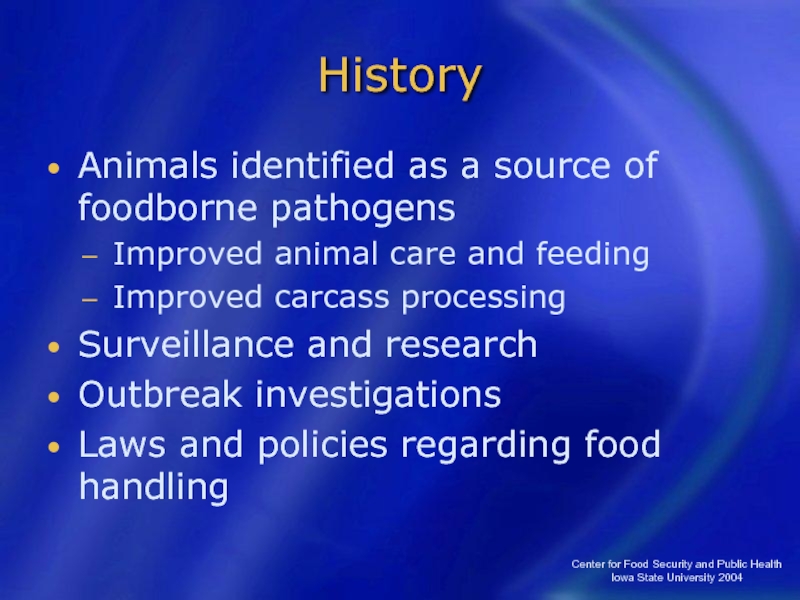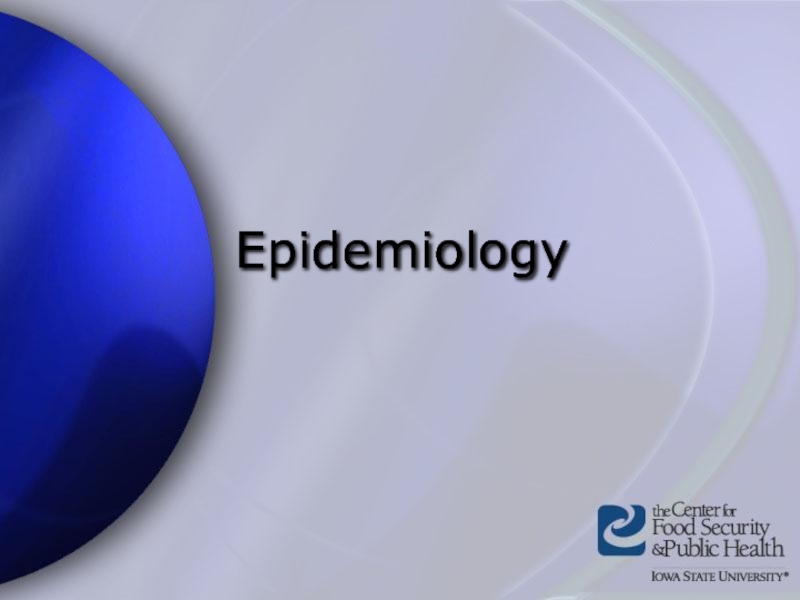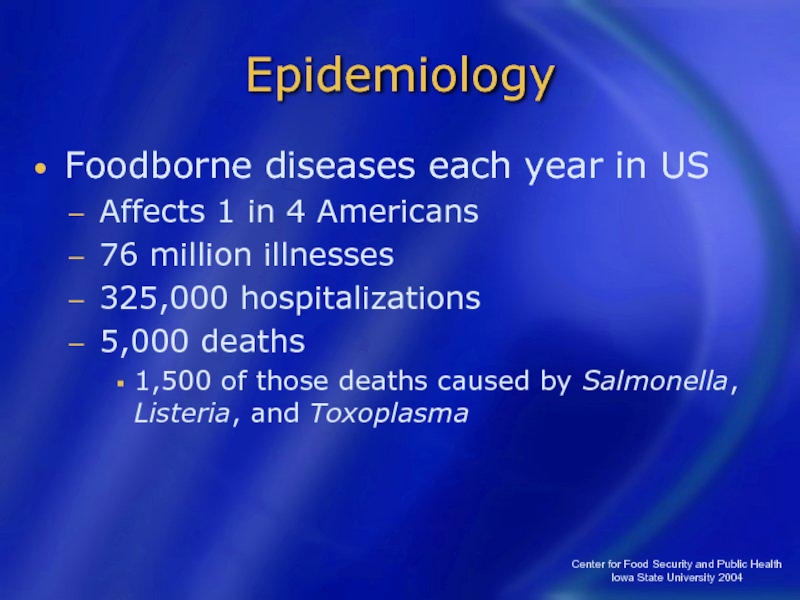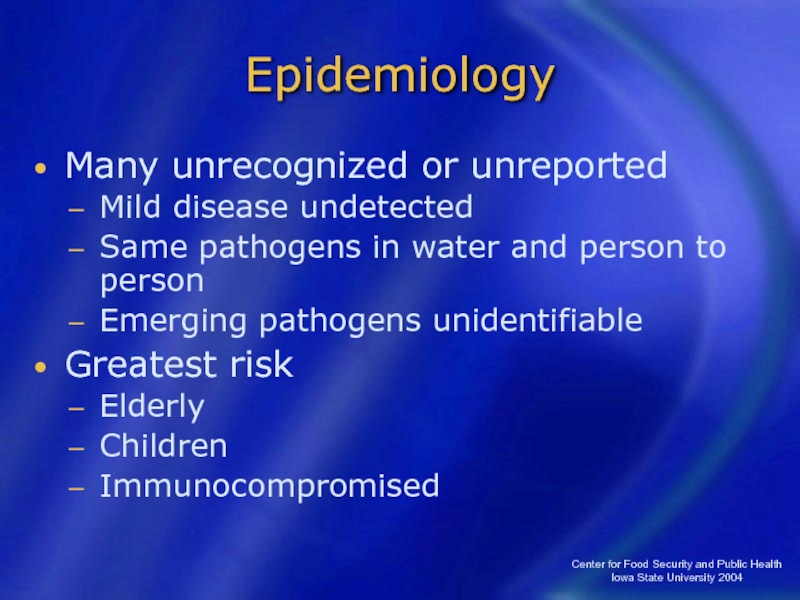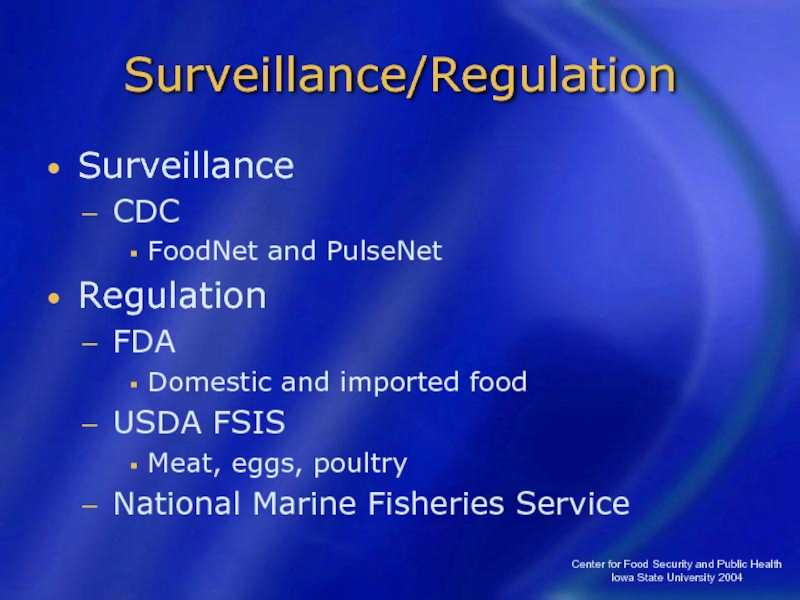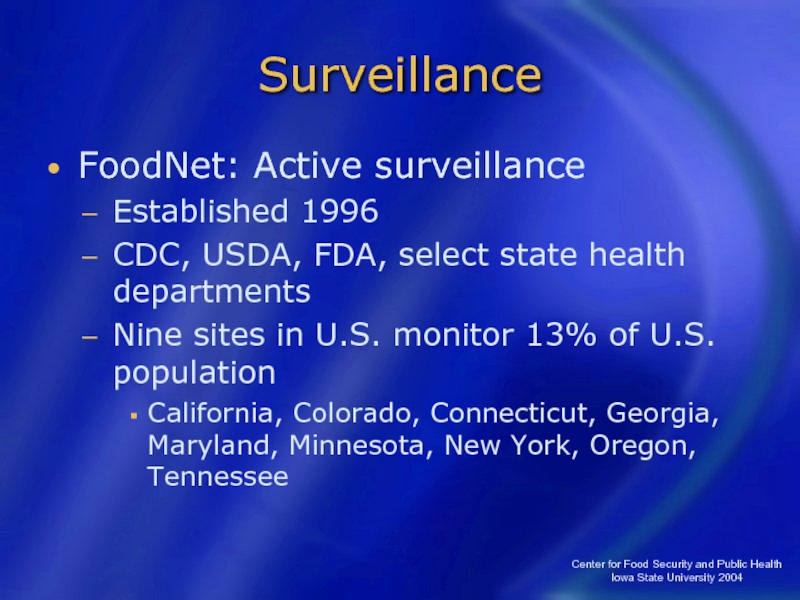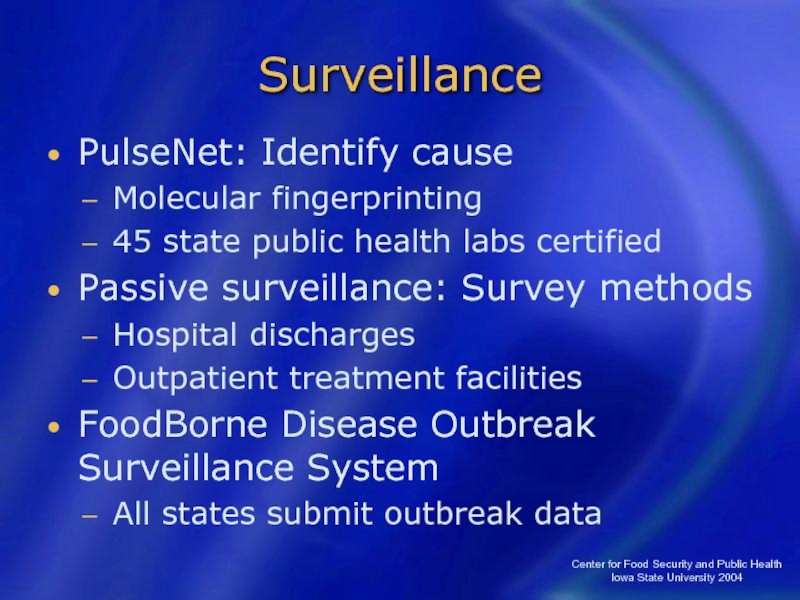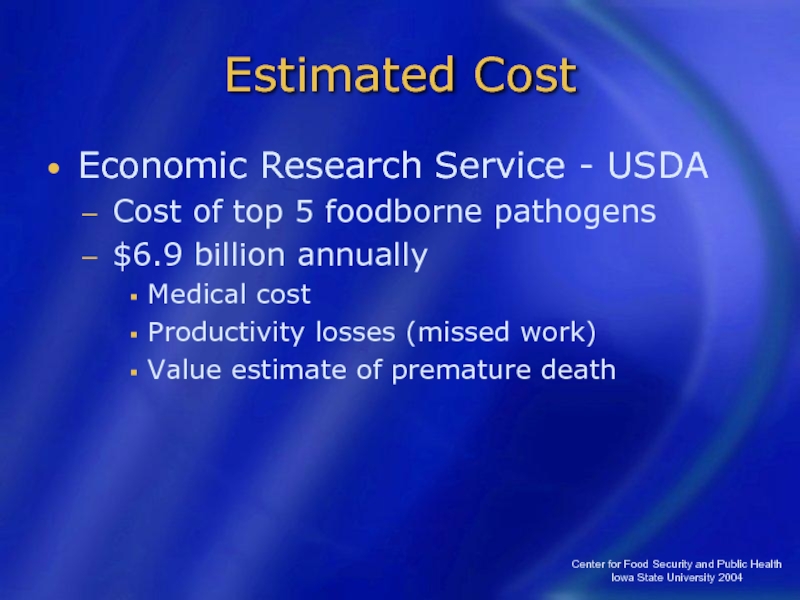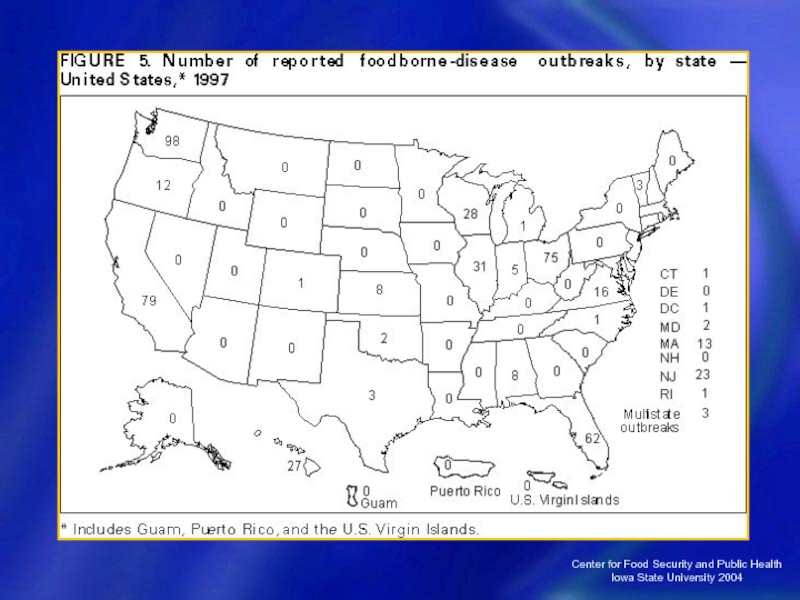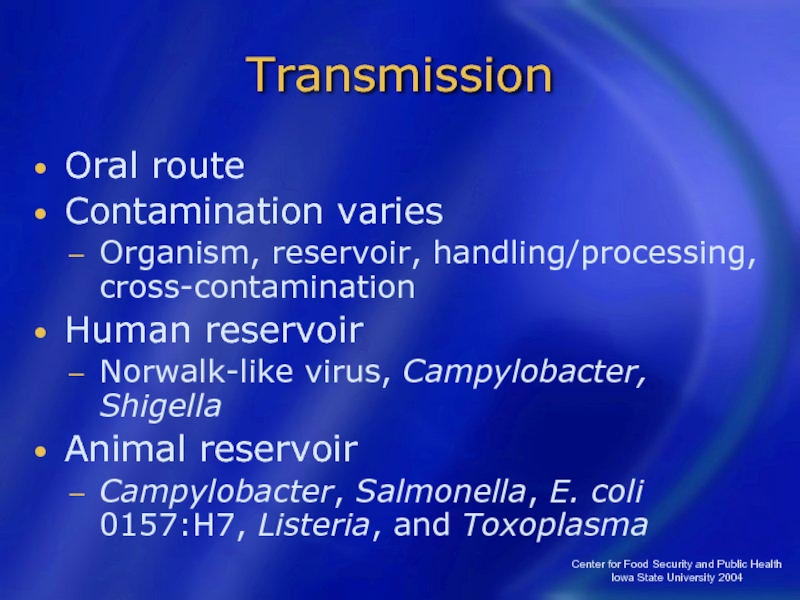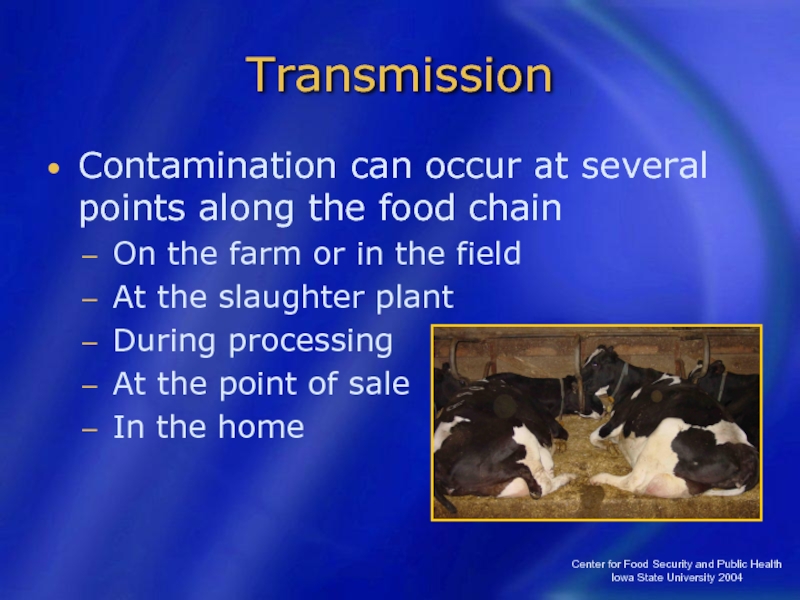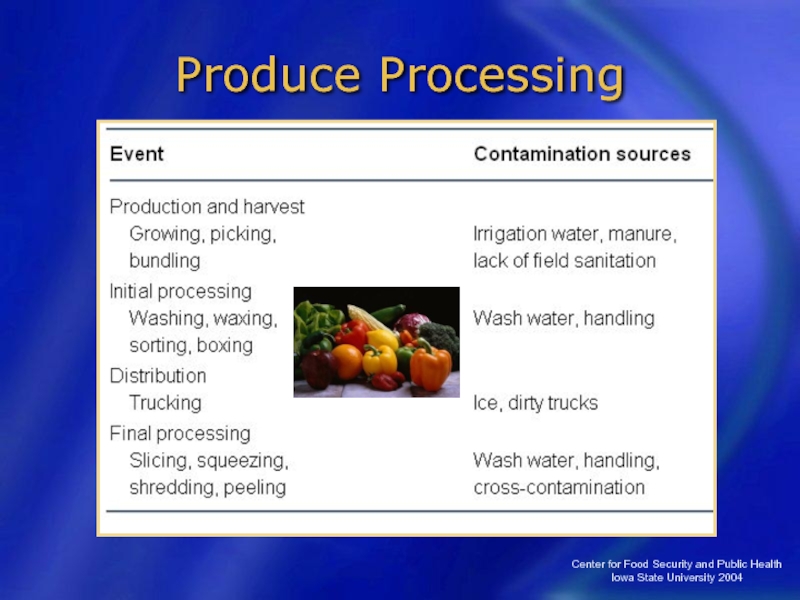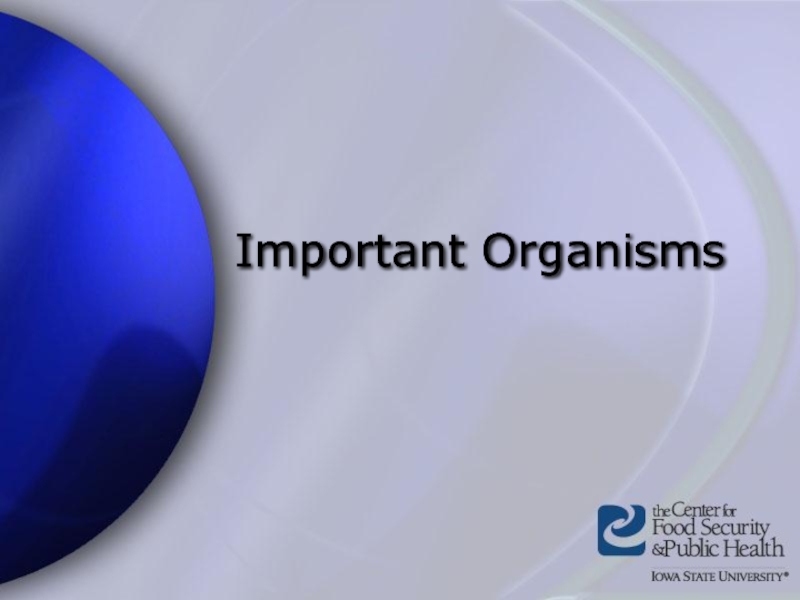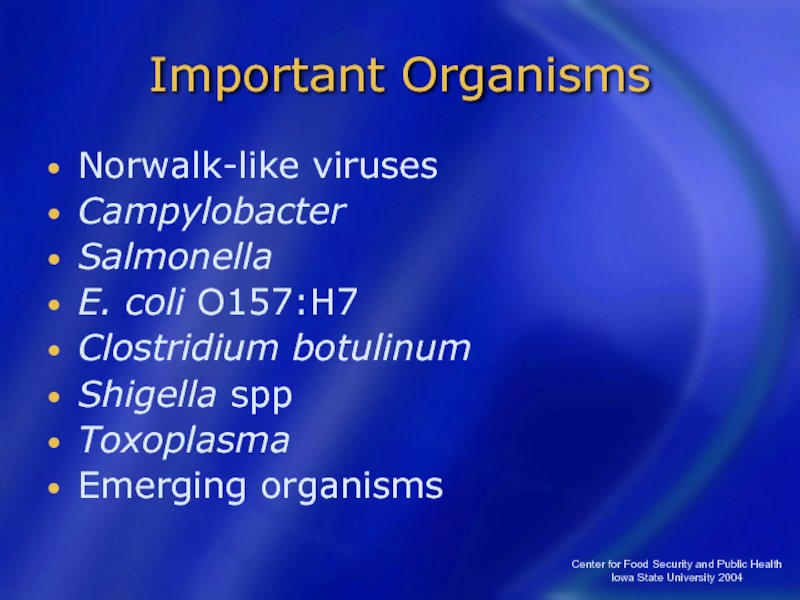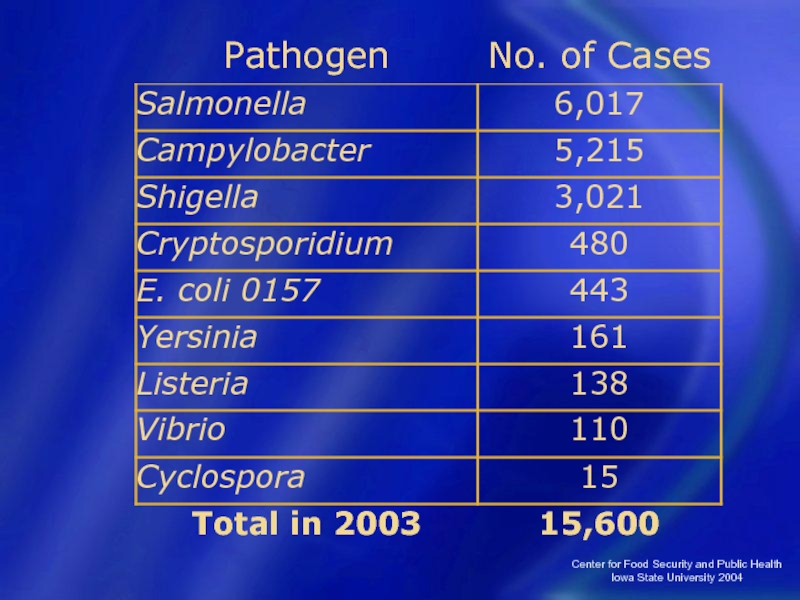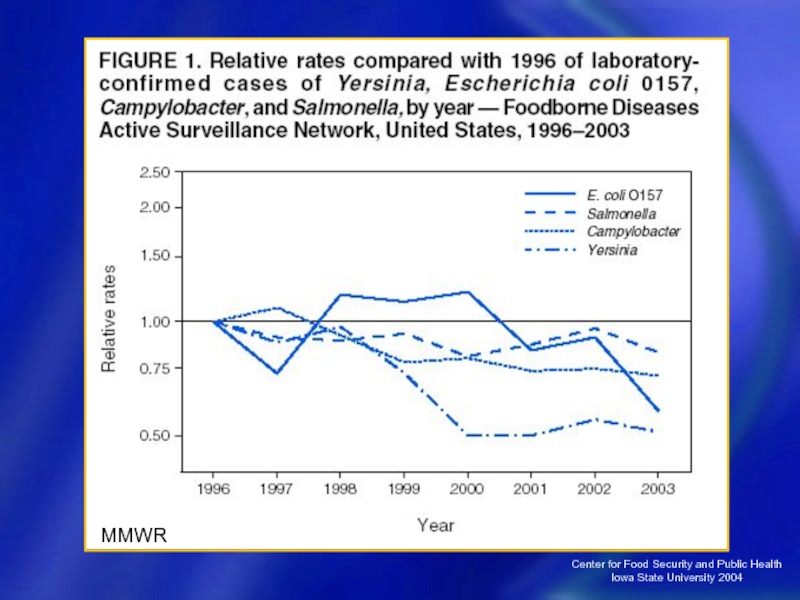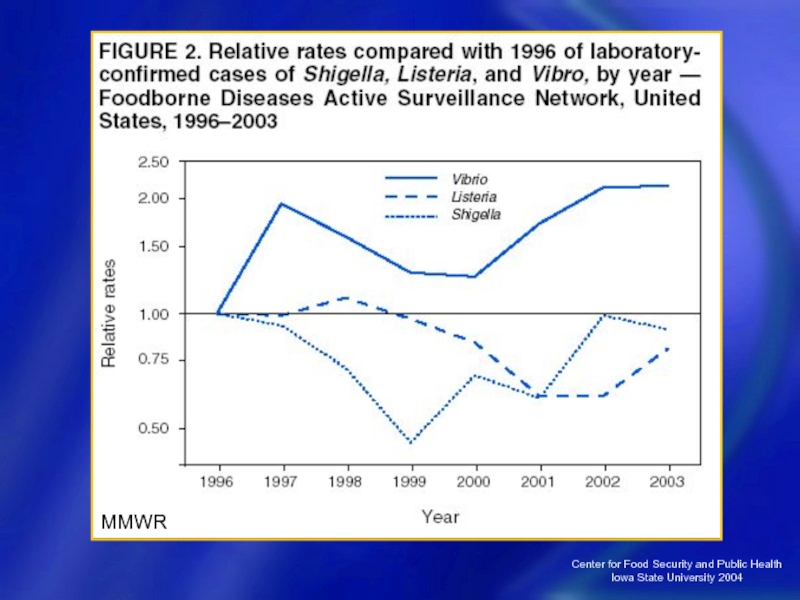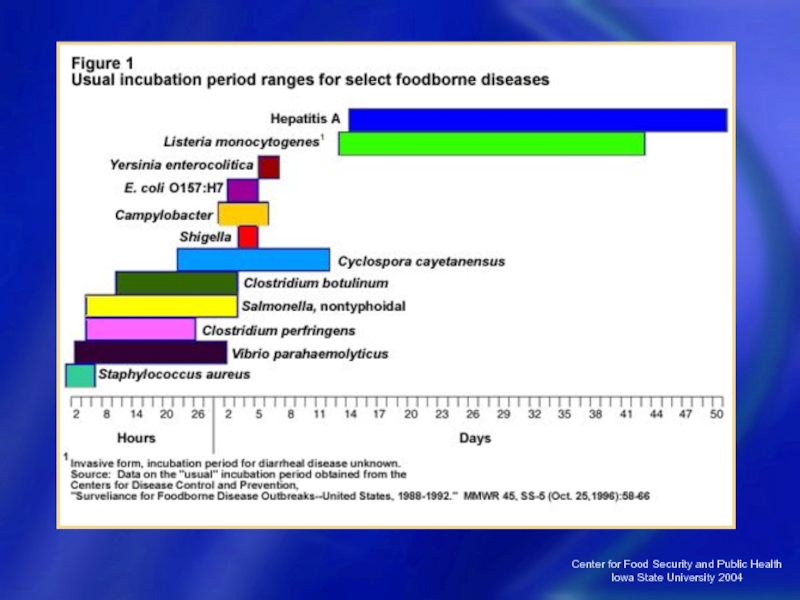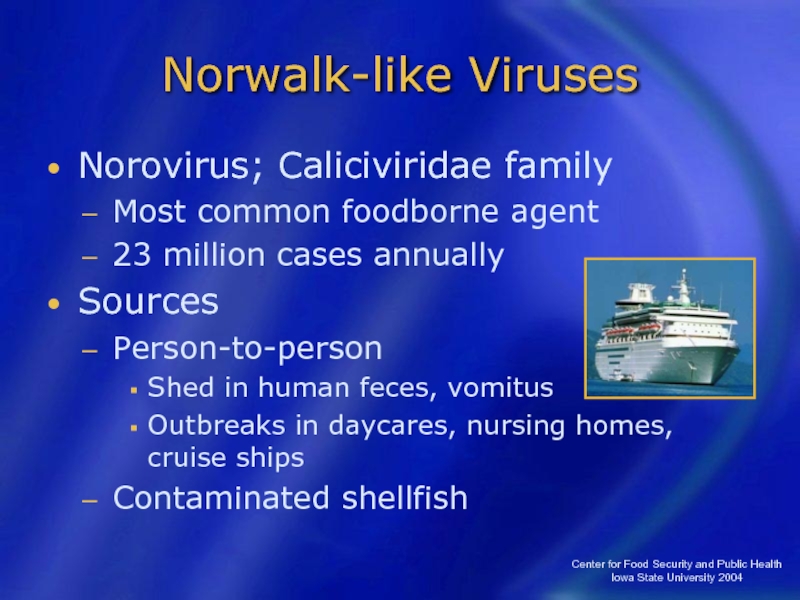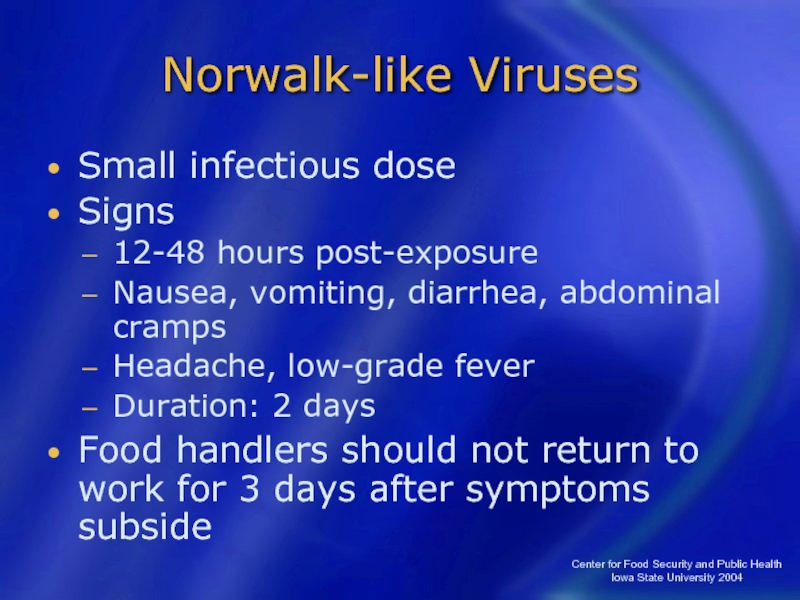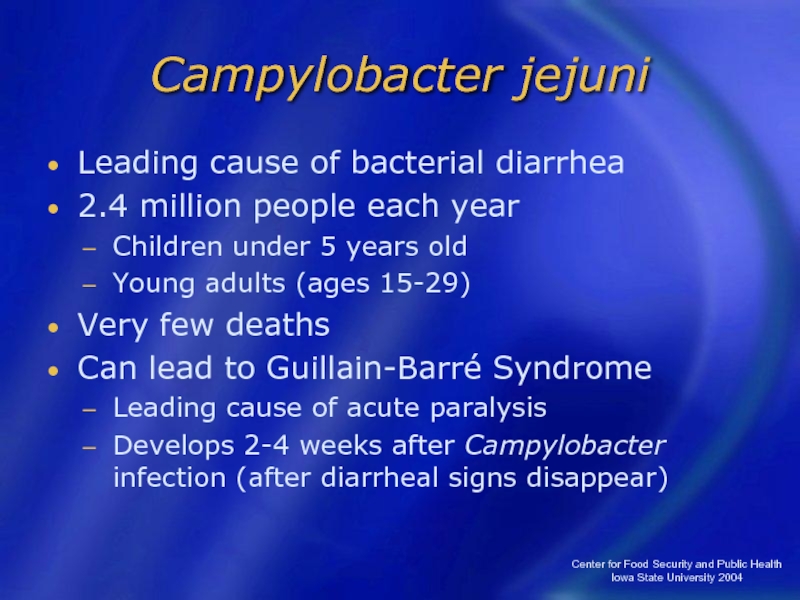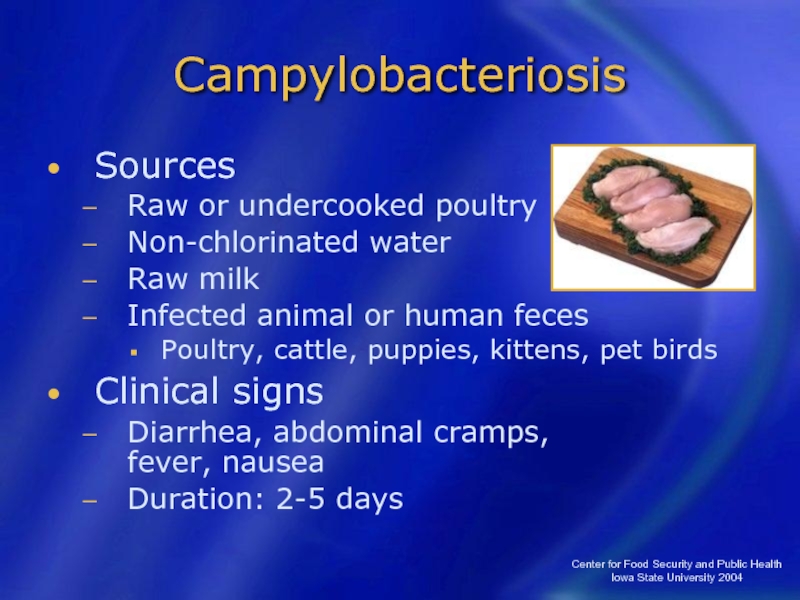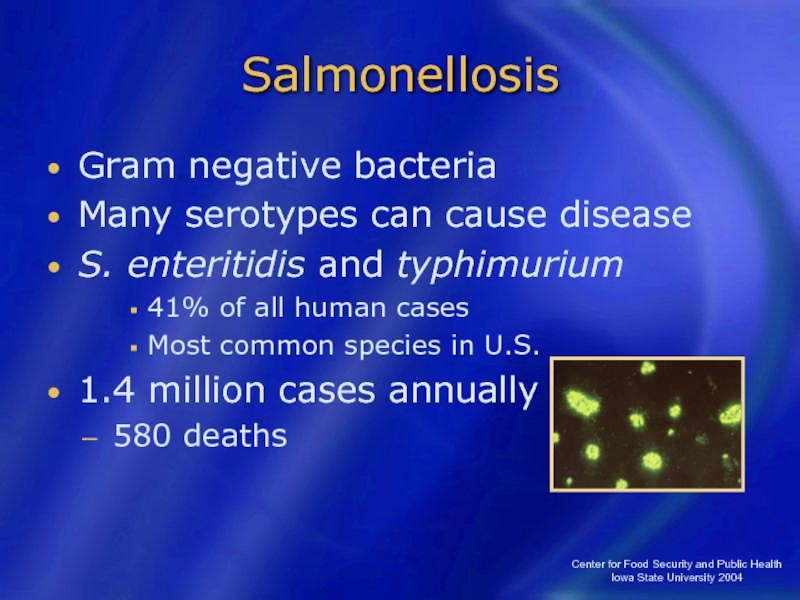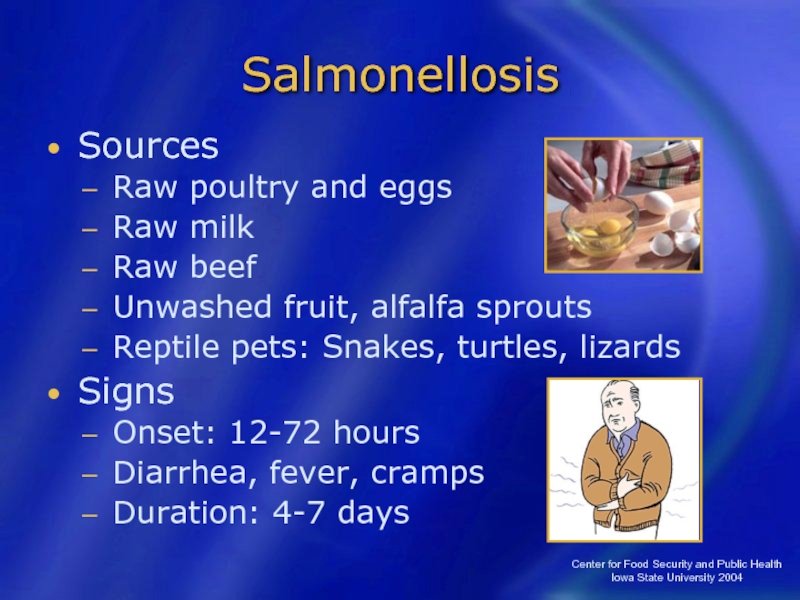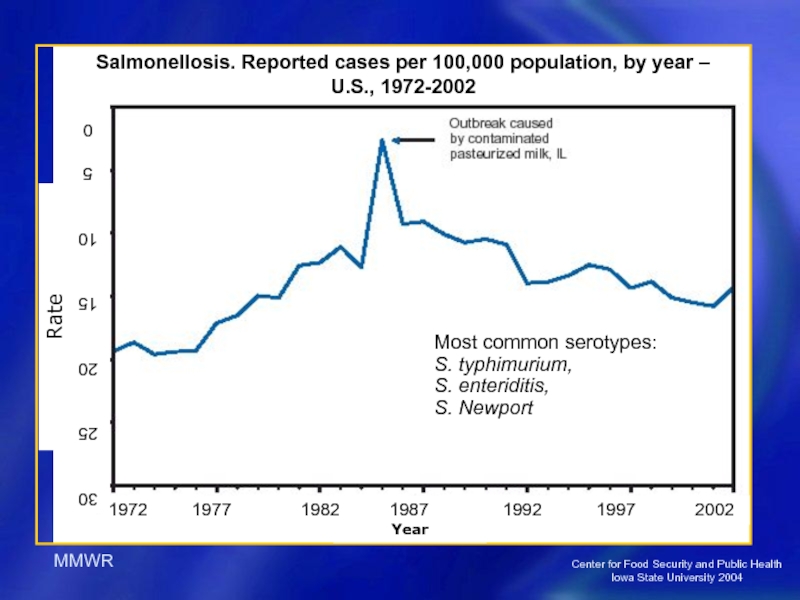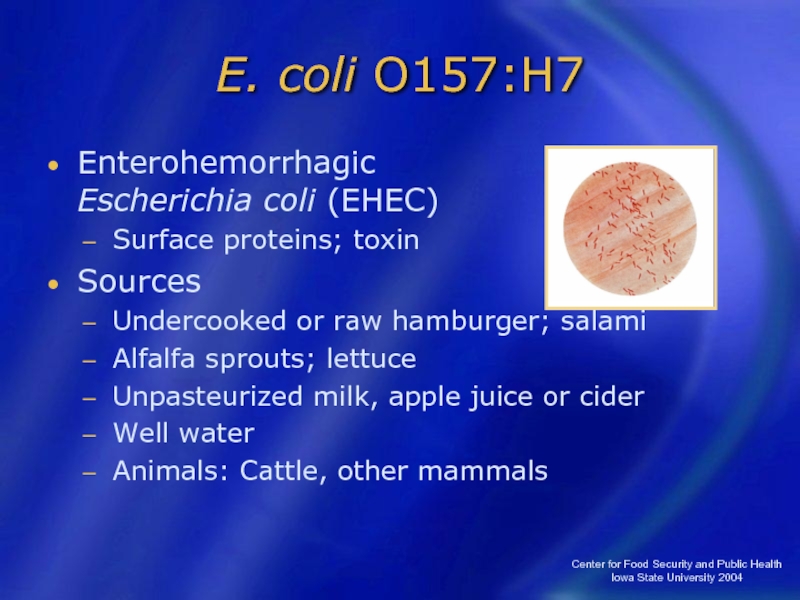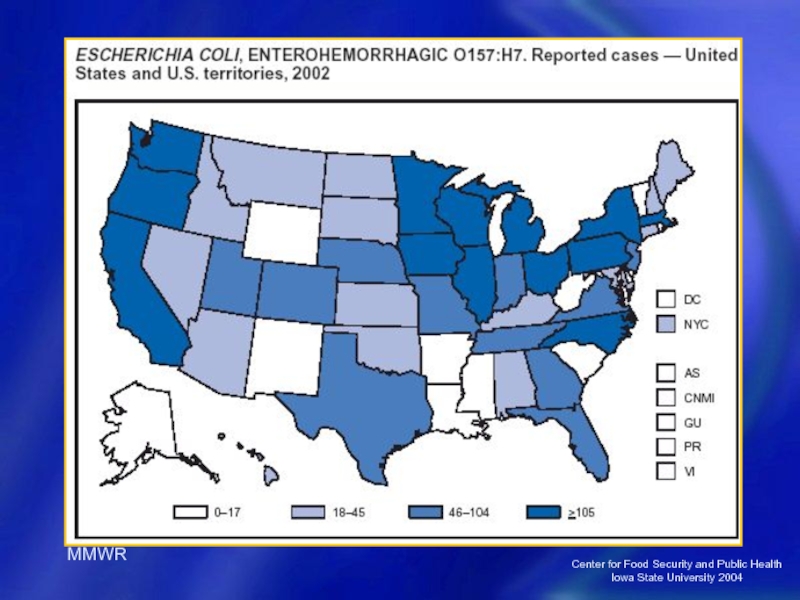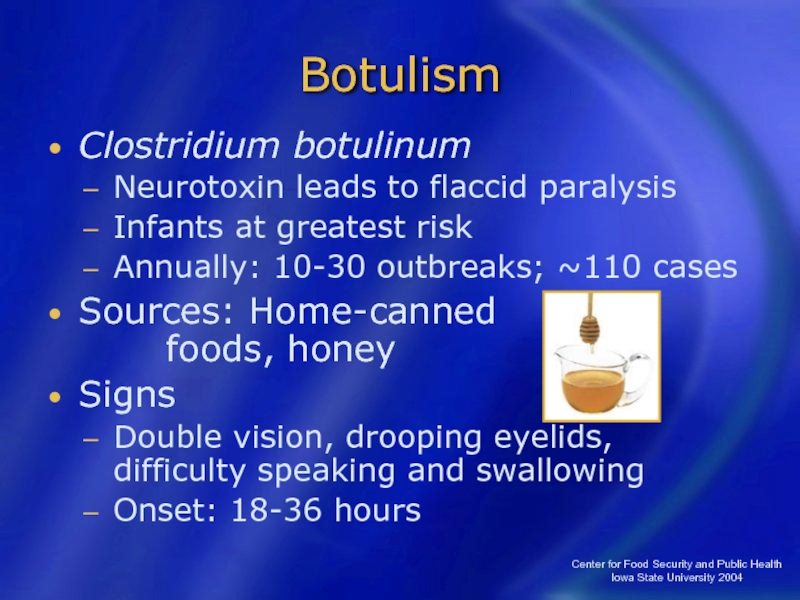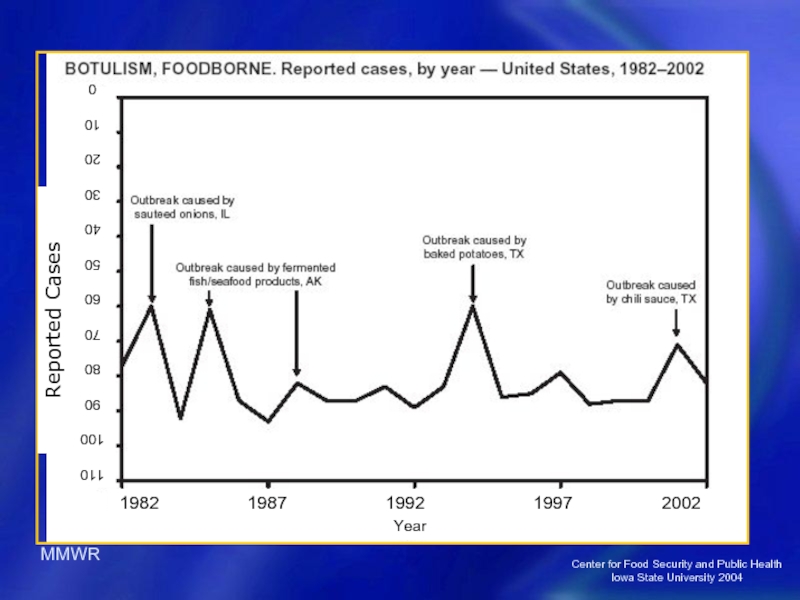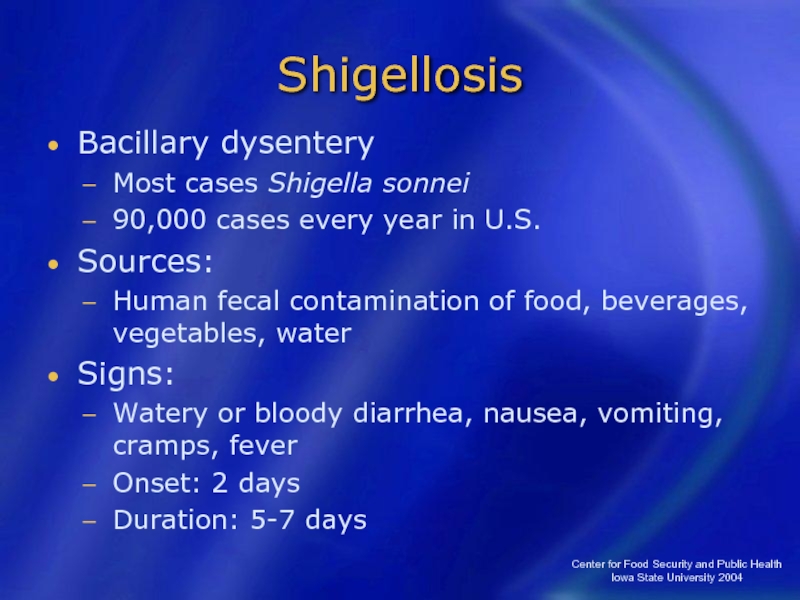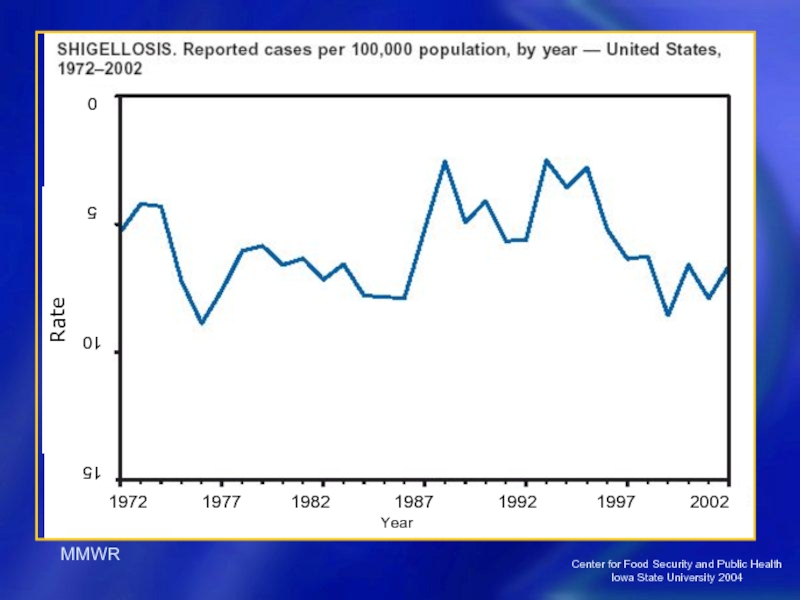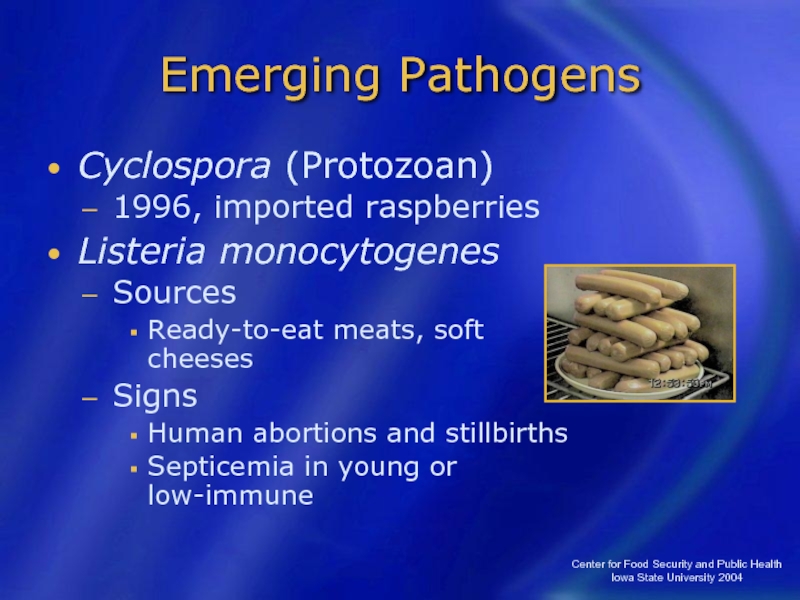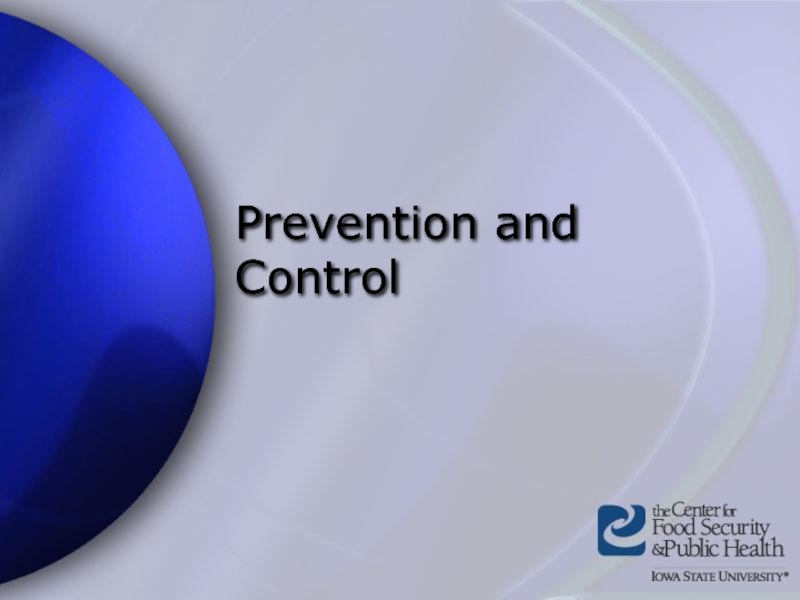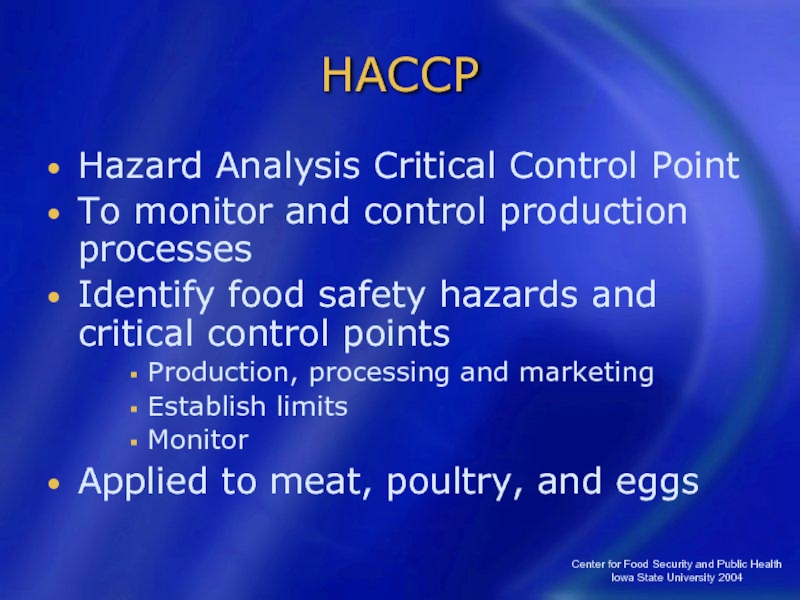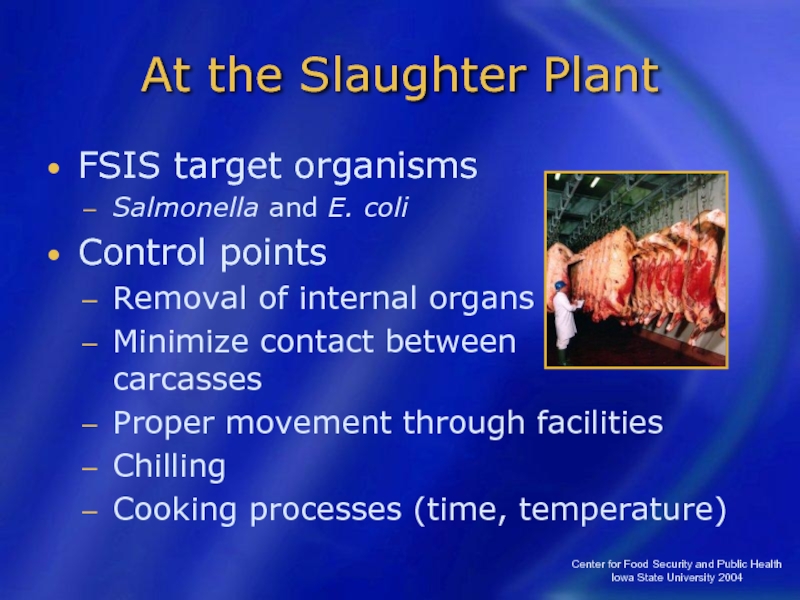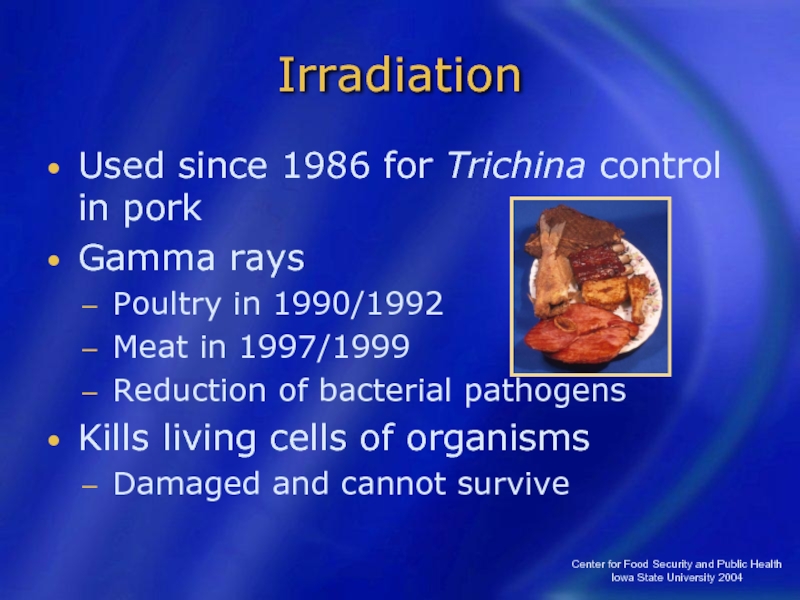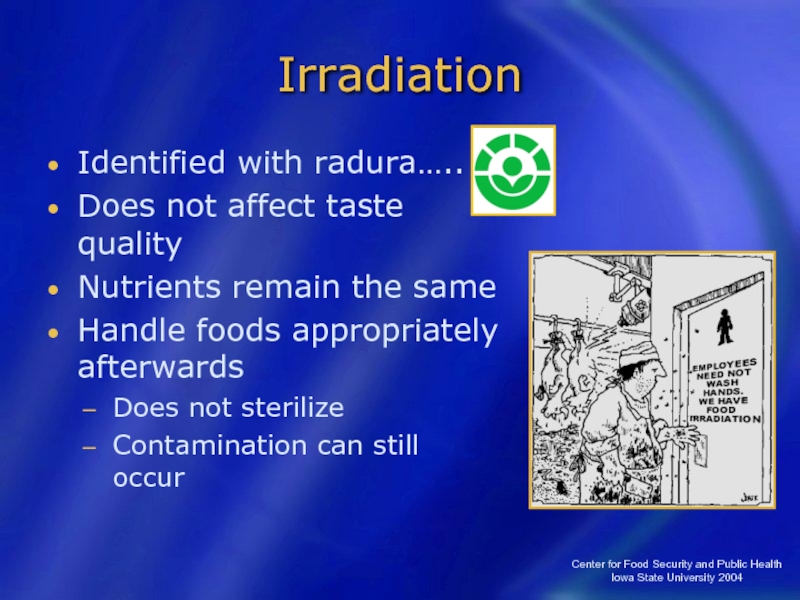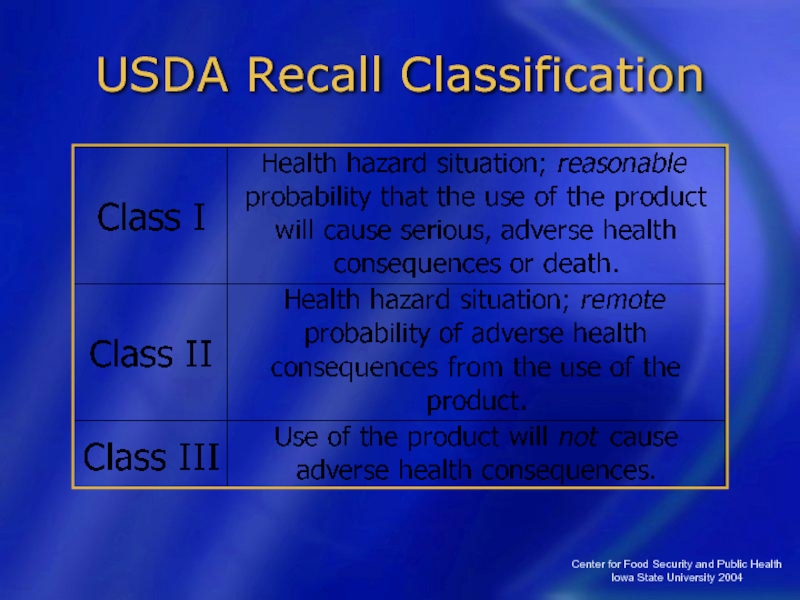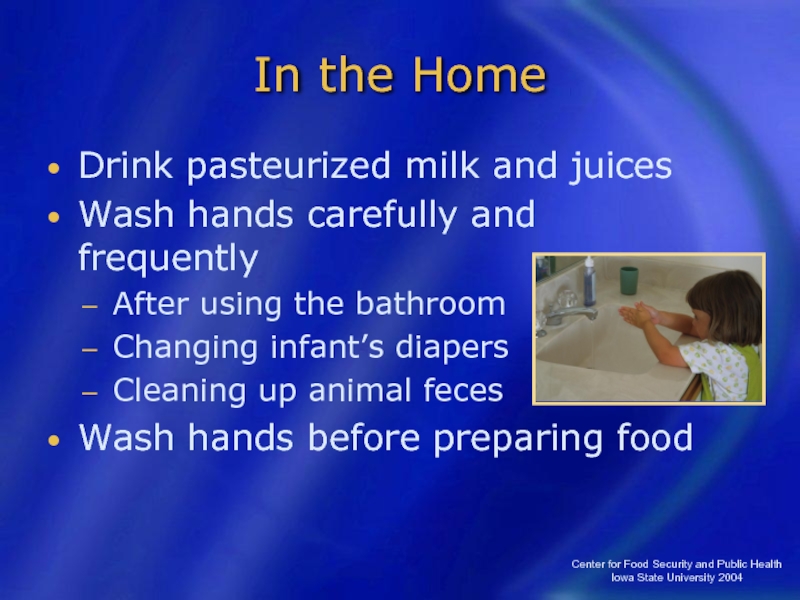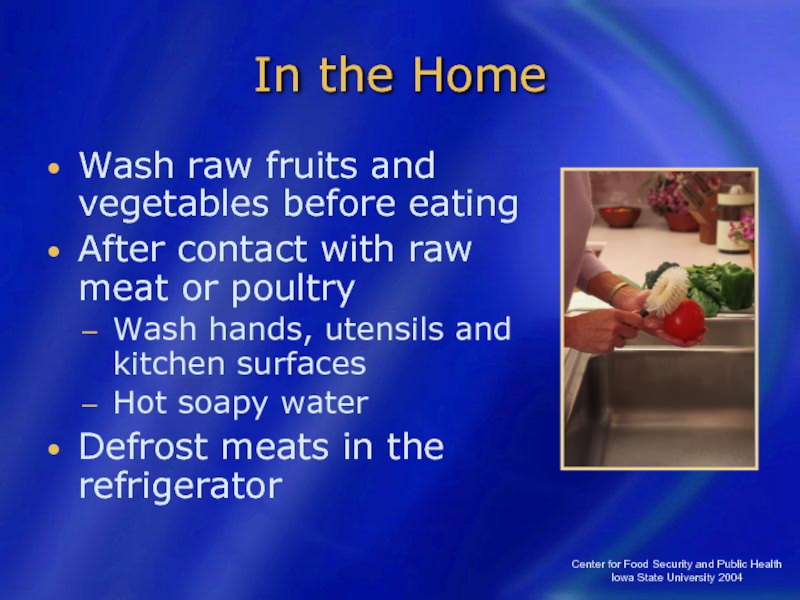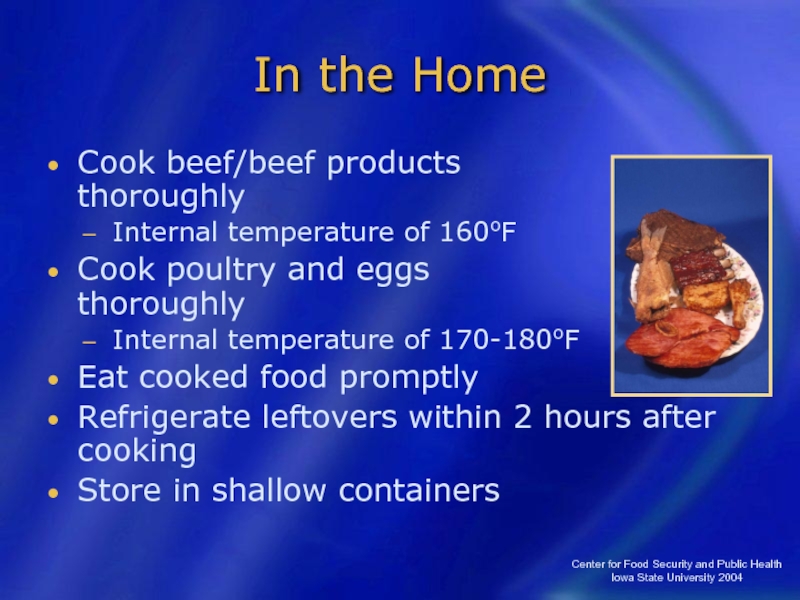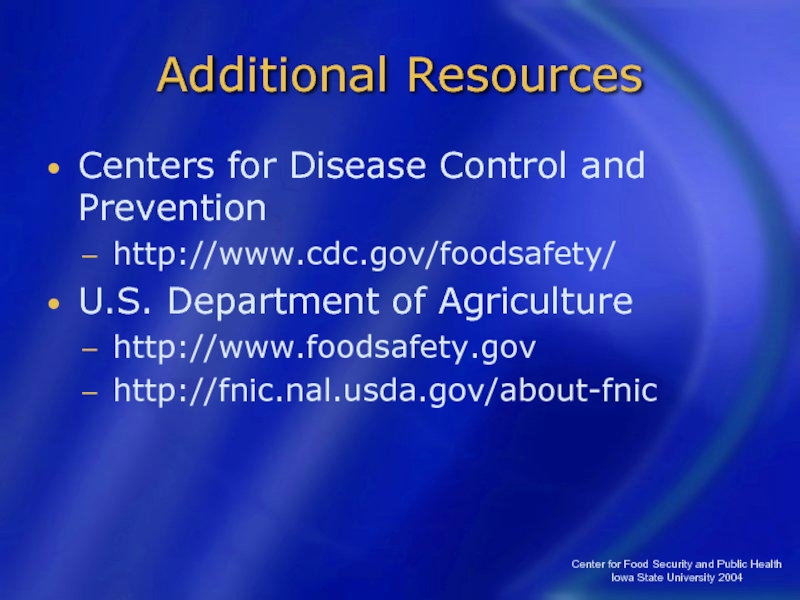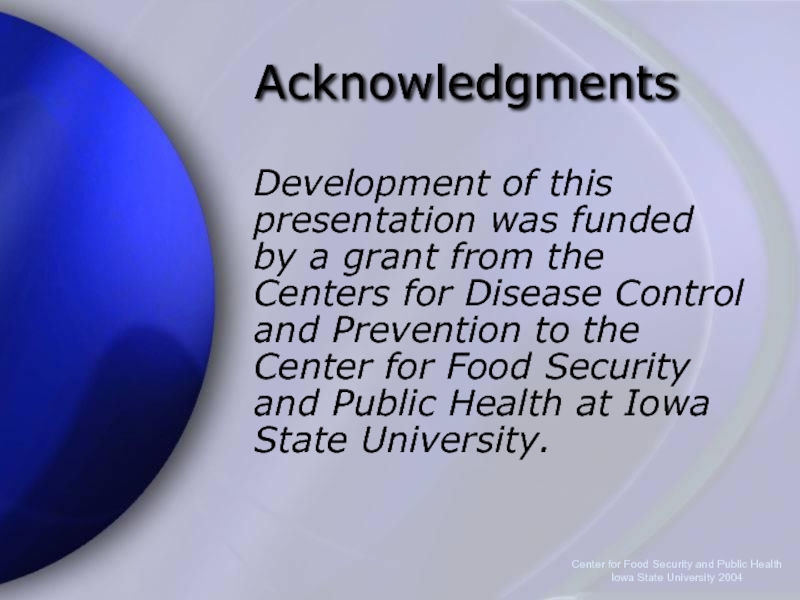- Главная
- Разное
- Дизайн
- Бизнес и предпринимательство
- Аналитика
- Образование
- Развлечения
- Красота и здоровье
- Финансы
- Государство
- Путешествия
- Спорт
- Недвижимость
- Армия
- Графика
- Культурология
- Еда и кулинария
- Лингвистика
- Английский язык
- Астрономия
- Алгебра
- Биология
- География
- Детские презентации
- Информатика
- История
- Литература
- Маркетинг
- Математика
- Медицина
- Менеджмент
- Музыка
- МХК
- Немецкий язык
- ОБЖ
- Обществознание
- Окружающий мир
- Педагогика
- Русский язык
- Технология
- Физика
- Философия
- Химия
- Шаблоны, картинки для презентаций
- Экология
- Экономика
- Юриспруденция
Food Safety презентация
Содержание
- 1. Food Safety
- 2. Center for Food Security and Public Health
- 3. Center for Food Security and Public Health
- 4. Center for Food Security and Public Health
- 5. History
- 6. Center for Food Security and Public Health
- 7. Center for Food Security and Public Health
- 8. Epidemiology
- 9. Center for Food Security and Public Health
- 10. Center for Food Security and Public Health
- 11. Center for Food Security and Public Health
- 12. Center for Food Security and Public Health
- 13. Center for Food Security and Public Health
- 14. Center for Food Security and Public Health
- 15. Center for Food Security and Public Health Iowa State University 2004
- 16. Transmission
- 17. Center for Food Security and Public Health
- 18. Center for Food Security and Public Health
- 19. Center for Food Security and Public Health Iowa State University 2004 Produce Processing
- 20. Important Organisms
- 21. Center for Food Security and Public Health
- 22. Center for Food Security and Public Health Iowa State University 2004
- 23. Center for Food Security and Public Health Iowa State University 2004 MMWR
- 24. Center for Food Security and Public Health Iowa State University 2004 MMWR
- 25. Center for Food Security and Public Health Iowa State University 2004
- 26. Center for Food Security and Public Health
- 27. Center for Food Security and Public Health
- 28. Center for Food Security and Public Health
- 29. Center for Food Security and Public Health
- 30. Center for Food Security and Public Health
- 31. Center for Food Security and Public Health
- 32. Center for Food Security and Public Health
- 33. Center for Food Security and Public Health
- 34. Center for Food Security and Public Health
- 35. Center for Food Security and Public Health Iowa State University 2004 MMWR
- 36. Center for Food Security and Public Health
- 37. Center for Food Security and Public Health
- 38. Center for Food Security and Public Health
- 39. Center for Food Security and Public Health
- 40. Center for Food Security and Public Health
- 41. Center for Food Security and Public Health
- 42. Center for Food Security and Public Health Iowa State University 2004
- 43. Prevention and Control
- 44. Center for Food Security and Public Health
- 45. Center for Food Security and Public Health
- 46. Center for Food Security and Public Health
- 47. Center for Food Security and Public Health
- 48. Center for Food Security and Public Health
- 49. Center for Food Security and Public Health Iowa State University 2004 USDA Recall Classification
- 50. Center for Food Security and Public Health
- 51. Center for Food Security and Public Health
- 52. Center for Food Security and Public Health
- 53. Center for Food Security and Public Health
- 54. Center for Food Security and Public Health
- 55. Center for Food Security and Public Health
Слайд 2Center for Food Security and Public Health Iowa State University
Overview
Organisms
History
Epidemiology
Transmission
Foodborne illness
Prevention and Control
Слайд 3Center for Food Security and Public Health Iowa State University
Organisms
Estimated 250 foodborne pathogens
Foodborne illness
2 or more cases of a similar illness resulting from ingestion of a common food
Bacteria most common cause
Also viruses, parasites, natural and manufactured chemicals, and toxins from organisms
Слайд 4Center for Food Security and Public Health Iowa State University
Foodborne disease outbreaks, cases and deaths
1993-1997
Salmonella had the highest number
Слайд 6Center for Food Security and Public Health Iowa State University
History
Early 1900’s
Contaminated food, milk and water caused many foodborne illnesses
Sanitary revolution
Sewage and water treatment
Hand-washing, sanitation
Pasteurization of milk- 1908
Refrigeration in homes- 1913
Слайд 7Center for Food Security and Public Health Iowa State University
History
Animals identified as a source of foodborne pathogens
Improved animal care and feeding
Improved carcass processing
Surveillance and research
Outbreak investigations
Laws and policies regarding food handling
Слайд 9Center for Food Security and Public Health Iowa State University
Epidemiology
Foodborne diseases each year in US
Affects 1 in 4 Americans
76 million illnesses
325,000 hospitalizations
5,000 deaths
1,500 of those deaths caused by Salmonella, Listeria, and Toxoplasma
Слайд 10Center for Food Security and Public Health Iowa State University
Epidemiology
Many unrecognized or unreported
Mild disease undetected
Same pathogens in water and person to person
Emerging pathogens unidentifiable
Greatest risk
Elderly
Children
Immunocompromised
Слайд 11Center for Food Security and Public Health Iowa State University
Surveillance/Regulation
Surveillance
CDC
FoodNet and PulseNet
Regulation
FDA
Domestic and imported food
USDA FSIS
Meat, eggs, poultry
National Marine Fisheries Service
Слайд 12Center for Food Security and Public Health Iowa State University
Surveillance
FoodNet: Active surveillance
Established 1996
CDC, USDA, FDA, select state health departments
Nine sites in U.S. monitor 13% of U.S. population
California, Colorado, Connecticut, Georgia, Maryland, Minnesota, New York, Oregon, Tennessee
Слайд 13Center for Food Security and Public Health Iowa State University
Surveillance
PulseNet: Identify cause
Molecular fingerprinting
45 state public health labs certified
Passive surveillance: Survey methods
Hospital discharges
Outpatient treatment facilities
FoodBorne Disease Outbreak Surveillance System
All states submit outbreak data
Слайд 14Center for Food Security and Public Health Iowa State University
Estimated Cost
Economic Research Service - USDA
Cost of top 5 foodborne pathogens
$6.9 billion annually
Medical cost
Productivity losses (missed work)
Value estimate of premature death
Слайд 17Center for Food Security and Public Health Iowa State University
Transmission
Oral route
Contamination varies
Organism, reservoir, handling/processing, cross-contamination
Human reservoir
Norwalk-like virus, Campylobacter, Shigella
Animal reservoir
Campylobacter, Salmonella, E. coli 0157:H7, Listeria, and Toxoplasma
Слайд 18Center for Food Security and Public Health Iowa State University
Transmission
Contamination can occur at several points along the food chain
On the farm or in the field
At the slaughter plant
During processing
At the point of sale
In the home
Слайд 21Center for Food Security and Public Health Iowa State University
Important Organisms
Norwalk-like viruses
Campylobacter
Salmonella
E. coli O157:H7
Clostridium botulinum
Shigella spp
Toxoplasma
Emerging organisms
Слайд 26Center for Food Security and Public Health Iowa State University
Norwalk-like Viruses
Norovirus; Caliciviridae family
Most common foodborne agent
23 million cases annually
Sources
Person-to-person
Shed in human feces, vomitus
Outbreaks in daycares, nursing homes, cruise ships
Contaminated shellfish
Слайд 27Center for Food Security and Public Health Iowa State University
Norwalk-like Viruses
Small infectious dose
Signs
12-48 hours post-exposure
Nausea, vomiting, diarrhea, abdominal cramps
Headache, low-grade fever
Duration: 2 days
Food handlers should not return to work for 3 days after symptoms subside
Слайд 28Center for Food Security and Public Health Iowa State University
Campylobacter jejuni
Leading cause of bacterial diarrhea
2.4 million people each year
Children under 5 years old
Young adults (ages 15-29)
Very few deaths
Can lead to Guillain-Barré Syndrome
Leading cause of acute paralysis
Develops 2-4 weeks after Campylobacter infection (after diarrheal signs disappear)
Слайд 29Center for Food Security and Public Health Iowa State University
Campylobacteriosis
Sources
Raw or undercooked poultry
Non-chlorinated water
Raw milk
Infected animal or human feces
Poultry, cattle, puppies, kittens, pet birds
Clinical signs
Diarrhea, abdominal cramps,
fever, nausea
Duration: 2-5 days
Слайд 30Center for Food Security and Public Health Iowa State University
Salmonellosis
Gram negative bacteria
Many serotypes can cause disease
S. enteritidis and typhimurium
41% of all human cases
Most common species in U.S.
1.4 million cases annually
580 deaths
Слайд 31Center for Food Security and Public Health Iowa State University
Salmonellosis
Sources
Raw poultry and eggs
Raw milk
Raw beef
Unwashed fruit, alfalfa sprouts
Reptile pets: Snakes, turtles, lizards
Signs
Onset: 12-72 hours
Diarrhea, fever, cramps
Duration: 4-7 days
Слайд 32Center for Food Security and Public Health Iowa State University
1972 1977 1982 1987 1992 1997 2002
Year
30
25
20
15
10
5
0
Salmonellosis. Reported cases per 100,000 population, by year – U.S., 1972-2002
MMWR
Most common serotypes:
S. typhimurium,
S. enteriditis,
S. Newport
Rate
Слайд 33Center for Food Security and Public Health Iowa State University
E. coli O157:H7
Enterohemorrhagic Escherichia coli (EHEC)
Surface proteins; toxin
Sources
Undercooked or raw hamburger; salami
Alfalfa sprouts; lettuce
Unpasteurized milk, apple juice or cider
Well water
Animals: Cattle, other mammals
Слайд 34Center for Food Security and Public Health Iowa State University
E. coli O157:H7
Signs
Watery or bloody diarrhea, nausea, cramps
Onset: 2-5 days
Duration: 5-10 days
Sequela
Hemolytic Uremic Syndrome (HUS)
Acute kidney failure in children
Life threatening
Слайд 36Center for Food Security and Public Health Iowa State University
Botulism
Clostridium botulinum
Neurotoxin leads to flaccid paralysis
Infants at greatest risk
Annually: 10-30 outbreaks; ~110 cases
Sources: Home-canned
foods, honey
Signs
Double vision, drooping eyelids, difficulty speaking and swallowing
Onset: 18-36 hours
Слайд 37Center for Food Security and Public Health Iowa State University
Year
1982 1987 1992 1997 2002
Reported Cases
110
100
90
80
70
60
50
40
30
20
10
0
MMWR
Слайд 38Center for Food Security and Public Health Iowa State University
Shigellosis
Bacillary dysentery
Most cases Shigella sonnei
90,000 cases every year in U.S.
Sources:
Human fecal contamination of food, beverages, vegetables, water
Signs:
Watery or bloody diarrhea, nausea, vomiting, cramps, fever
Onset: 2 days
Duration: 5-7 days
Слайд 39Center for Food Security and Public Health Iowa State University
Year
1972 1977 1982 1987 1992 1997 2002
Rate
15
10
5
0
MMWR
Слайд 40Center for Food Security and Public Health Iowa State University
Toxoplasmosis
Toxoplasma gondii- intracellular protozoan
112,500 cases annually
Pregnant women/immunocompromised at greatest risk
Sources
Infected cats, soil, undercooked meat
Signs
Fever, headache, swollen lymph nodes
Слайд 41Center for Food Security and Public Health Iowa State University
Emerging Pathogens
Cyclospora (Protozoan)
1996, imported raspberries
Listeria monocytogenes
Sources
Ready-to-eat meats, soft cheeses
Signs
Human abortions and stillbirths
Septicemia in young or low-immune
Слайд 44Center for Food Security and Public Health Iowa State University
HACCP
Hazard Analysis Critical Control Point
To monitor and control production processes
Identify food safety hazards and critical control points
Production, processing and marketing
Establish limits
Monitor
Applied to meat, poultry, and eggs
Слайд 45Center for Food Security and Public Health Iowa State University
On Farm Strategies
Testing and removal for Salmonella
Serologic, fecal culture, hide culture
Vaccinating
Many serotypes
Varying effectiveness
Minimize rodents, wild birds
Isolation of new animals
Слайд 46Center for Food Security and Public Health Iowa State University
At the Slaughter Plant
FSIS target organisms
Salmonella and E. coli
Control points
Removal of internal organs
Minimize contact between carcasses
Proper movement through facilities
Chilling
Cooking processes (time, temperature)
Слайд 47Center for Food Security and Public Health Iowa State University
Irradiation
Used since 1986 for Trichina control in pork
Gamma rays
Poultry in 1990/1992
Meat in 1997/1999
Reduction of bacterial pathogens
Kills living cells of organisms
Damaged and cannot survive
Слайд 48Center for Food Security and Public Health Iowa State University
Irradiation
Identified with radura…..
Does not affect taste quality
Nutrients remain the same
Handle foods appropriately afterwards
Does not sterilize
Contamination can still occur
Слайд 49Center for Food Security and Public Health Iowa State University
USDA Recall Classification
Слайд 50Center for Food Security and Public Health Iowa State University
In the Home
Drink pasteurized milk and juices
Wash hands carefully and frequently
After using the bathroom
Changing infant’s diapers
Cleaning up animal feces
Wash hands before preparing food
Слайд 51Center for Food Security and Public Health Iowa State University
In the Home
Wash raw fruits and vegetables before eating
After contact with raw meat or poultry
Wash hands, utensils and kitchen surfaces
Hot soapy water
Defrost meats in the refrigerator
Слайд 52Center for Food Security and Public Health Iowa State University
In the Home
Cook beef/beef products thoroughly
Internal temperature of 160oF
Cook poultry and eggs thoroughly
Internal temperature of 170-180oF
Eat cooked food promptly
Refrigerate leftovers within 2 hours after cooking
Store in shallow containers
Слайд 53Center for Food Security and Public Health Iowa State University
Additional Resources
Centers for Disease Control and Prevention
http://www.cdc.gov/foodsafety/
U.S. Department of Agriculture
http://www.foodsafety.gov
http://fnic.nal.usda.gov/about-fnic
Слайд 54Center for Food Security and Public Health Iowa State University
Acknowledgments
Development of this presentation was funded by a grant from the Centers for Disease Control and Prevention to the Center for Food Security and Public Health at Iowa State University.
Слайд 55Center for Food Security and Public Health Iowa State University
Acknowledgments
Author:
Co-authors:
Reviewer:
Glenda Dvorak, DVM, MS, MPH
Danelle Bickett-Weddle, DVM, MPH
Radford Davis, DVM, MPH
Jean Gladon, BS
